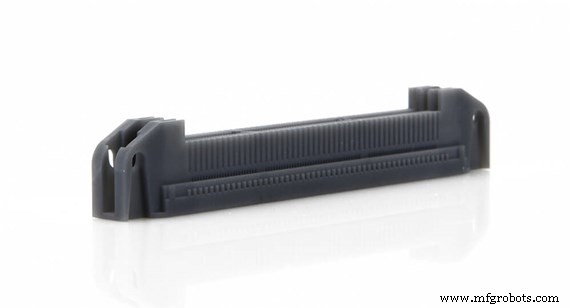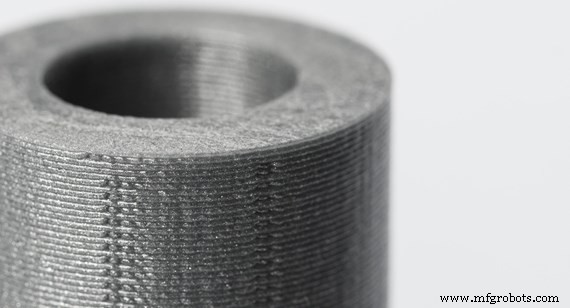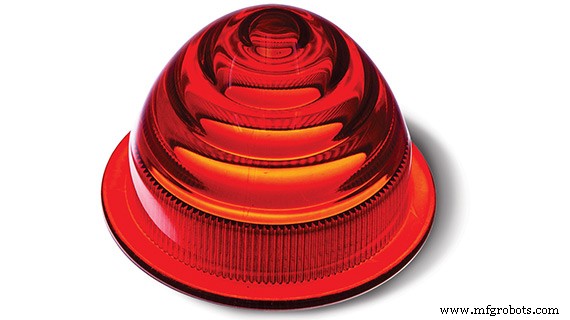SLA и FDM:сравнение распространенных технологий 3D-печати
Аддитивное производство, и особенно современная 3D-печать, прошли долгий путь с момента своего первоначального развития в 1983 году. Сегодняшние детали, напечатанные на 3D-принтере, могут достигать высокого разрешения и допусков. Двумя наиболее распространенными методами являются стереолитография (SLA) и моделирование методом наплавления (FDM). Хотя оба они появились в 1980-х годах, в них используются совершенно разные способы изготовления деталей, и в результате каждая готовая деталь дает разные преимущества.
 Детали SLA, изготовленные из смолы Protolabs MicroFine Grey™, обеспечивают микроточное разрешение.
Детали SLA, изготовленные из смолы Protolabs MicroFine Grey™, обеспечивают микроточное разрешение. Как работает SLA?
SLA использует фотополимерные смолы в качестве сырья для своих деталей. Фотополимерам для затвердевания требуется интенсивный ультрафиолетовый свет лазера, и это основная идея SLA. Сборка происходит на платформе, погруженной в смолу. Лазер находится над резервуаром и, направляемый прецизионными зеркалами, сплавляет жидкую смолу, затвердевая для достижения желаемой формы детали, по одному слою за раз. Опорные конструкции — это первые созданные слои, обеспечивающие надежное крепление детали к платформе и адекватную поддержку. С каждым проходом лезвие устройства для повторного нанесения покрытия разрушает поверхностное натяжение смолы над деталью. Затем деталь строится снизу вверх.
Как работает FDM?
Одна из самых ранних форм 3D-печати, FDM, была изобретена одним из основателей Stratasys Скоттом Крампом. Концепция проста — это очень похоже на использование пистолета для горячего клея. Термопластичная нить или катушка из пластика нагревается до точки плавления. Горячий жидкий пластик выходит через сопло, образуя тонкий единый слой вдоль осей X и Y на строительной платформе. Слой быстро остывает и затвердевает. По мере завершения каждого слоя платформа опускается и наносится дополнительный расплав пластика, увеличивая деталь вертикально (вдоль оси Z).
Материальные свойства SLA и FDM
| Обработка | Как это работает | Сила | Готово | Общие материалы |
|---|---|---|---|---|
| SLA | Фотополимер, отверждаемый лазером | 2 500–10 000 (psi) 17,2–68,9 (МПа) | Добавочные слои 0,002–0,006 дюйма (0,051–0,152 мм) обычно | Термопластичные фотополимеры, похожие на ABS, PC и PP |
| FDM | Слитные выдавливания | 5 200–9 800 (psi) 35,9–67,6 (МПа) | Добавочные слои 0,005–0,013 дюйма (0,127–0,330 мм) обычно | ABS, PC, PC/ABS, PPSU, PEEK, ULTEM |
 На этой части FDM видны линии слоев. Фото:3Dhubs.com
На этой части FDM видны линии слоев. Фото:3Dhubs.com Neither of these techniques creates parts as strong as ones that are injection molded, for example, but they are suitable for rapid prototyping. SLA’s thin layers and strong bonding between the layers makes its parts smoother, with minimal striations along the Z axis, the direction of the build.
SLA Considerations
If details and surface smoothness are important for your part, SLA handily beats FDM. In part, because of its roots in laser technology, SLA parts can offer incredibly fine detail, yet pricing is competitive. Also, the SLA ultraviolet light curing process avoids FDM’s issues caused by heat compressing previously drawn layers. Equally important, SLA offers many additional finishing options, such as dyeing and texturing.
With SLA, there are three resolution levels from which to choose, ranging from 0.004 in. (0.1016mm) to 0.001 in. (0.0254mm) for layer thickness. Choosing one over the other not only affects part quality, but manufacturing time, too. Minimum feature size can be as small as 0.0025 in. (0.0635mm) on the XY plane and 0.008 in. (0.2032mm) on the Z axis.
One important issue with SLA parts is their sensitivity to light. As photopolymers, they can degrade from exposure to UV rays, such as sunlight. Adding a protective coating can slow this process.
MicroFine™ is an exclusive Protolabs material available in gray and green. This micro-resolution, ABS-like material can print layers that are extremely thin:just 0.001 in. (0.0254mm). That kind of precision is a prerequisite for building parts with many small feature details and is regularly used for small and highly accurate medical components.
FDM Considerations
FDM uses engineering-grade materials (see chart above) and offers a range of color options. With some FDM printers, parts can be as large as 427 in. x 153 in. x 172 in. (10,845.8mm x 3,886.2mm x 4,368.8mm). Essentially it depends on the size of the build space. Also, FDM parts are moderately priced, making it ideal for hobbyists, dental offices, and classrooms.
FDM’s tolerance is dependent on how the machine is set up, but can be as small as +/-0.0035 in. (+/-0.0015mm). Layer thickness varies based on the material you’re using, and some printers can print as thin as 0.001 in. (0.0254mm), although this would lead to long print times and may not be possible with larger parts.
Because temperature affects the core material, FDM parts are subject to rippled exterior edges caused as new layers are dropped atop previous layers. These Z-axis issues also cause weakness in the build. So, a part’s strength is entirely dependent on the direction in which it was built.
FDM does not do well with wide, flat areas, and has difficulties printing sharp corners, so adding fillets to your design makes sense. For all these reasons, prototyping with FDM works well when accuracy and surface finish aren't critical.
Although FDM gets the check for cost, SLA is quite competitive, especially for cosmetic prototypes with intricate designs. It’s also a go-to process to create forms for injection molding and casting.
When to Use SLA and FDM
With all of these considerations in mind, here is a list of when to use either method.
Use SLA :
- For rapid, complex prototyping
- When precision and a smooth surface finish is important
- When high resolution, fine detail, and accuracy is necessary
- For creating molds for casting to facilitate mass production
- When strength and durability of the model is not crucial (models made from resin may suffer when exposed to the sun for long periods)
Use FDM :
- For prototyping
- When a selection of colors is needed
- For low-cost models
- When precision and surface finish aren’t crucial
- For hobbyist and maker projects

SLA produced this clear, red taillight with a smooth finish and custom post-production painting.
For additional help, feel free to contact a Protolabs applications engineer at 877-479-3680 or [email protected]. To get your next design project started today, simply upload a 3D CAD model for an interactive quote within hours.
Промышленные технологии
- 5 распространенных мифов о 3D-печати
- 3D-печать FDM:сравнение нитей ASA, PETG и ПК
- Развенчание 9 распространенных мифов о 3D-печати
- 3D-печать FDM:где мы сегодня?
- Сравнение 3D-технологий:SLA и FDM
- Стереолитография (SLA) Советы по дизайну 3D-печати
- MJF и SLS:сравнение технологий 3D-печати
- 3D-печать FDM:настольная и промышленная
- Технологии 3D-печати (часть 2)
- Литье в песчаные формы с использованием технологий 3D-печати



